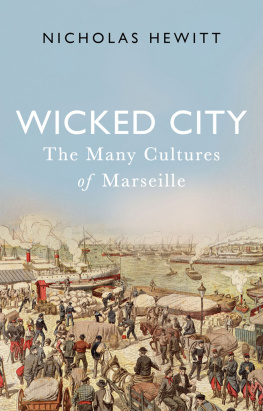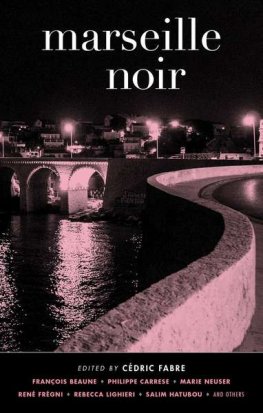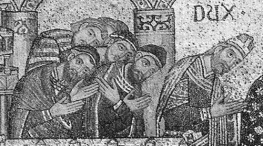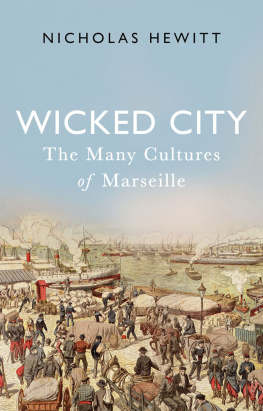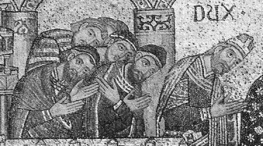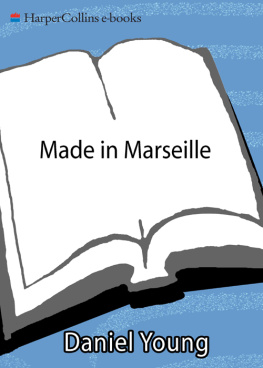WICKED CITY
NICHOLAS HEWITT
Wicked City
The Many Cultures of Marseille

HURST & COMPANY, LONDON
First published in the United Kingdom in 2019 by
C. Hurst & Co. (Publishers) Ltd.,
41 Great Russell Street, London, WC1B 3PL
Nicholas Hewitt, 2019
Maps Stephen Ramsay Cartography, 2019
All rights reserved.
The right of Nicholas Hewitt to be identified as the author of this publication is asserted by him in accordance with the Copyright, Designs and Patents Act, 1988.
A Cataloguing-in-Publication data record for this book is available from the British Library.
EISBN: 9781787383593
www.hurstpublishers.com
CONTENTS
This project has benefited from the collections of many museums, galleries and libraries, as well as from the helpful advice and suggestions of numerous friends and colleagues. I am grateful to the staff of the London Library, whose assistance has been of inestimable value, of the British Library, and to the library of the Muse dHistoire and the Bibliothque de lAlcazar, whose staff were unfailingly helpful and courteous. The collections of the Muse de lImmigration in Paris and the Muse des Beaux-Arts, the Muse dHistoire, MuCEM, the Chambre de Commerce and the Muse Cantini in Marseille were also rich sources of visual and documentary material. I am also unfailingly grateful to those friends and colleagues who have helped me to formulate my ideas on Marseille over a long period, in particular Yves Doazan and Jean-Louis Fabiani, who selflessly gave up their time to help me organise a conference at the Vieux-Charit in Marseille in 2013 and who, along the way, shared their rich knowledge of the city with me; and Professor David Pomfret, of the University of Hong Kong, who made available to me his work in the Marseille Archives Municipales on the cultural life of the city during the Belle Epoque. I am also grateful to Emyr Tudwal Jones and Margaret-Anne Hutton, who more or less simultaneously introduced me to the work of Jean-Claude Izzo; to John Flower and Pascal Ory for their advice and comments on the progress of the book; to my colleagues on the Editorial Board of French Cultural Studies, who have shared their insights into Marseille, especially Sue Harris, Steven Ungar and Herman Lebovics; and to Tania Woloshyn, who co-edited a volume of essays on the Midi with me and introduced me to aspects of Southern painting of which I was unaware. I am also deeply conscious of the debt I owe to Catherine Davies and Richard Fardon for their constant interest in this project and particularly for their efforts in helping secure a very happy publishing home at Hurst. In Marseille, my debt is also to Franois Thomazeau, the citys most gifted biographer and pioneer of the Marseille polar, who has shared his insights with me, and, especially, to Mary Fitzgerald, who has taken from the outset a caring interest in the progress of this book and has helped to steer it through the complexities of contemporary Marseille. Finally, I am grateful to Stephen Ramsay for the maps of Marseille, and to the production team at Hurst, in particular my editor, Lara Weisweiller-Wu. As always, the greatest debt goes to my wife, Helen Meller, for her constant concern and advice. It was with her that I explored Marseille in the late 1990s when she was researching her own book on European cities.
Nicholas Hewitt
| Fig. 1. | Engraving by Franz Hogenberg of sixteenth century Marseille in Atlas of Cities/Civitas Orbis Terrarum, Vol II ed. Georg Braun (1575, Cologne). (Ullsteinbild/Topfoto). |
| Fig. 2. | Alexandre Dumas, The Count of Monte Cristo (18445). (1996 Penguin Classics edition) (Front cover Penguin Books Ltd). |
| Fig. 3. | Zarafa the giraffe by Nicholas Het (17701828). ( The Morgan Library & Museum, NY. Purchased with Sunny Crawford Blow Fund 1978). |
| Fig. 4. | Le Palais Longchamps. (Photo courtesy of Muse dHistoire de Marseille). |
| Fig. 5. | Strike in Marseille 1901, watched by an Italian docker. Artist, Louis Sabattier for LIllustration, 30 March 1901. ( David Nathan-Maister. SSPL/ Getty Images). |
| Fig. 6. | Marseille docks, early twentieth century. (Gallica: Bibliothque Nationale de France, Dpartement Estampes et Photographie). |
| Fig. 7. | The Transporter Bridge. (Gallica: Bibliothque Nationale de France, Dpartement Estampes et Photographie). |
| Fig. 8. | Vieux Port from Transporter Bridge. (Gallica: Bibliothque Nationale de France, Dpartement Estampes et Photographie). |
| Fig. 9. | Poster: Marseilles First Exposition Coloniale 1906 [David Dellepiane]. (History Collection/Alamy). |
| Fig. 10. | Poster: Marseille Exposition Coloniale 1922 [Leonetto Cappiello] (Gallica: Bibliothque Nationale de France ENT DN-1). |
| Fig. 11. | Marseille Exposition Coloniale 1922. West African Village. (Gallica: Bibliothque Nationale de France, Dpartement Estampes et Photographie). |
| Fig. 12. | Pavilion of Indo-China under construction for 1922 Exposition. (Gallica: Bibliothque Nationale de France, Dpartement Estampes et Photographie). |
| Fig. 13. | Viaduc lEstaque, Georges Braque, 1908. ( ADAGP, Paris, licensed by DACS, London). |
| Fig. 14. | Le Vieux Port, Paul Signac, 1905. (Metropolitan Museum of Art, NYC [public domain]). |
| Fig. 15. | French journalist and writer, Albert Londres (18841932). (Roger-Viollet/Topfoto). |
| Fig. 16. | Street scene in poor area: women washing at public tap 1938. Circa 1930. (Roger-Viollet/Topfoto). |
| Fig. 17. | Street scene in poor area near the Vieux Port, 1930. (Roger-Viollet/Topfoto). |
| Fig. 18. | La Canebire in the 1920s. (Gallica: Bibliothque Nationale de France, Dpartement Estampes et Photographie). |
| Fig. 19. | Front cover of Les Cahiers du Sud, 1932. (Manuscripts and Special Collections, University of Nottingham). |
| Fig. 20. | Jazz music venue in Marseille, advert in Les Cahiers du Sud, 1931. (Manuscripts and Special Collections, University of Nottingham). |
| Fig. 21. | Advertisement for Aropostale. Les Cahiers du Sud,1933. (Manuscripts and Special Collections, University of Nottingham). |
| Fig. 22. | Poster for Topaze, play by Marcel Pagnol. (Cci/Shutterstock). |
| Fig. 23. | Poster for Marius, film of the play by Marcel Pagnol. (Alamy). |
| Fig. 24. | The unemployed at the Vieux Port during the Great Depression. (IMAGNO/Topfoto). |
| Fig. 25. | Jean-Claude Izzo (19452000) Marseillais poet, playwright and novelist of neo-noir crime novels, taken in Strasbourg, 1998. (Olivier Roller, photographer, www.olivierroller.com). |

Map 1: Marseille and the Mediterranean

Map 2: Marseille and the Provence Region

